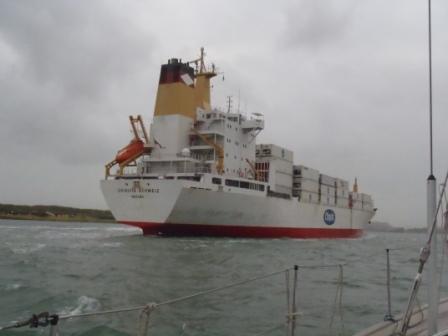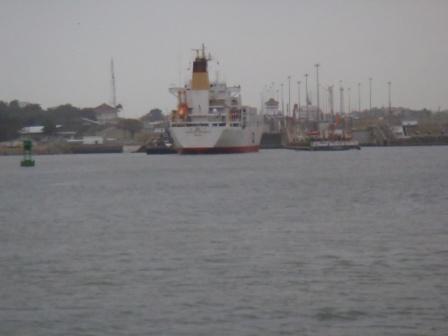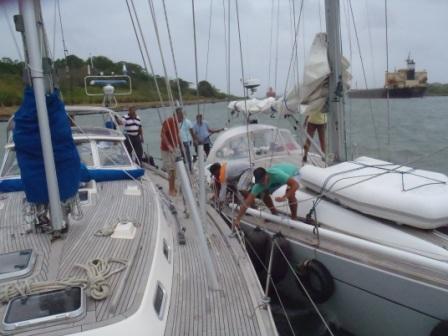Panama Canal transit "08:54.43N 79:31.74W" Part 1

VulcanSpirit
Richard & Alison Brunstrom
Fri 9 Mar 2012 00:17
|
Well, we've done it. Most unfortunately the Canal
Company require yacht passages to take place at night, so we saw very little
after darkness fell, but we are now safely anchored in the Pacific(!!) at
the entrance to the Canal. Weather here much better - hot and sunny. And 5m
tides of which more later
Canal transit was largely uneventful but not an
endeavour to be undertaken lightly. This is a canal built for big robust steel
ships, not the fragile eggshells that are cruising yachts. What follows is a
long & semi-technical recitation of a canal passage in a yacht - apologies
for those not moved by the intricacies of canalling. But I am, and it's my
Blog.
So, here we are following 'Chiquita Schweiz' on a
grey, miserable and very windy late afternoon':
 Going uphill the commercial vessel with which you
are going to share the lock goes first. Gatun locks are a triple staircase
(three locks in a line, connected directly together with no intervening bits of
canal) with a total rise of 26m. Amazing to think that you can get across the
giant continent of the Americas by boat with a rise of only 26m, given the
existence of the Andes and the Rockies. The locks are also dualled, with a
central island. All locks work in both directions depending on traffic flow.
Here is 'Chiquita' entering the bottom chamber of
the eastern flight with the central island (which is well over a mile long) on
the right and the western flight to the far right; the lock house just to the
right of the ship is at the summit level which shows just how low the isthmus
is:
 The ships move under their own power, and are held
in place by steel hawsers, at least one at each corner, taken to railway locos
running on a rack system (so they can climb the steep gradients, like the
Snowdon Mountain Railway) along both sides of the lock. The locos
don't drag the ship, they just hold it steady and central in the
chamber.
We went through these locks in a raft of three
yachts tied together with us in the centre. Rafting up at sea under power is an
interesting experience. Here we are feverishly tying our boat to an Italian one
called 'Downunder'. Four ropes - bow and stern lines, and forward and aft
springs to stop the boat moving relative to each other. It's very important to
make sure the masts are not opposite each other as turbulence can cause the
boats to bob around and if the rigging gets entangled it can cause expensive
trouble. Each yacht carries a person to steer, four line handlers (in our case,
all yachties, but often locals hired for the trip as on 'Downunder'), lots of
fenders and four long lines:
 |